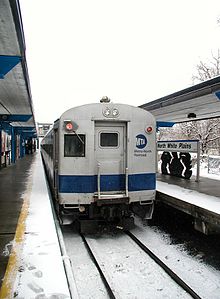MP75
| ACMU | |
|---|---|

ACMU at the North White Plains station in 2004.
|
|
| In service | 1950–2004 |
| Manufacturer | 4500 series: St. Louis Car Company 4600/4700 series, MP75: Pullman Standard |
| Constructed | 4500 series: 1950–1951 4600 series: 1962 4700 series: 1962–1965 MP75: 1963 |
| Number built | 4500 series: 100 4600 series: 26 4700 series: 61 MP75: 30 |
| Number preserved | 2 |
| Formation | single unit |
| Fleet numbers |
Saint Louis Car:
|
| Capacity | 130 |
| Operator(s) |
New York Central Penn Central Railroad Conrail Metro-North Long Island Rail Road |
| Specifications | |
| Doors | 2 vestibule doors |
| Maximum speed | 80 mph (130 km/h) |
| Weight | 114,000 lbs |
| Prime mover(s) | 4 × GE 1240 (100 hp) 4 x WE 1453-A (100 HP) - LIRR MP75 only |
| Power output | 400hp |
| Train heating | Electric heat, air conditioning |
| Electric system(s) | 660 VDC |
| Current collection method | third rail |
| Braking system(s) | Pneumatic, |
| Safety system(s) | emergency brakes |
| Coupling system | AAR |
The ACMUs (short for Air Conditioned Multiple Unit) were a series of DC electric multiple unit railcars built for the New York Central railroad in three batches between 1950 and 1965, with a fourth batch supplied to the Long Island Rail Road as the class MP75 in 1963. The ACMUs were intended to replace/supplement the original fleet of heavyweight MU cars, some of which dated to the start of electric operations on both railroads. These were the first New York Central units to offer air conditioning, with sealed windows replacing the drop sash and clerestory types found on earlier cars. The initial set of 100 cars was retired in 1970, upon completion of the M1 railcar delivery, while the second and third batches, totaling 87 cars, remained in service until 2004, when they were replaced by the new M7 fleet. The Long Island cars were eventually converted to non-powered push-pull coaches before being retired in the late 1990s.
The ACMU fleet was intended to replace some of the oldest MU cars on the New York Central system, many of which were already 40 years old and dated from the start of electrified service in 1906. The first series of 100 cars were ordered from the St. Louis Car company in 1949 and paid for by the New York Central railroad itself. 10 years later the financial condition of the railroad had deteriorated while the original MU fleet had only gotten older and less reliable. In 1962, the Central ordered an additional batch of 26 ACMUs from Pullman Standard and to assist the Central improve its commuter rail service, the Port Authority of New York and New Jersey purchased an additional 27 cars which were numbered in the 4700 series to distinguish them from the Central owned cars in the 4600 series. In 1965 a second order of 34 4700 cars were purchased by the Port Authority bringing the total of 4600/4700 series cars to 87.
In 1968, the New York Central was merged into the Penn Central railroad and the 4500 series were renumbered into the 1000 series and the 4600 and 4700 units renumbered into the combined 1100 series. With the railroad's finances worse than ever, the state acted to further prop up the ailing commuter operations and its fleet of several hundred remaining pre-war MU cars through the purchase of 174 new M1A "Metropolitan" railcars which were delivered between 1971 and 1973. By this point, the original 4500 series was 20 years old and in need of a mid-life overhaul. Due to the effects of deferred maintenance that took place in the 1950s, before the State funding became available, the decision was made to simply replace the fleet with new M1As instead of attempting to rebuild the run-down 4500s, although one car, #1037, lingered in service for several more years as a special car for a private commuter club. Starting in 1976, Conrail took over the state supported commuter operations from the bankrupt Penn Central using the combined fleet of M1As and 1100 series ACMUs.
...
Wikipedia
